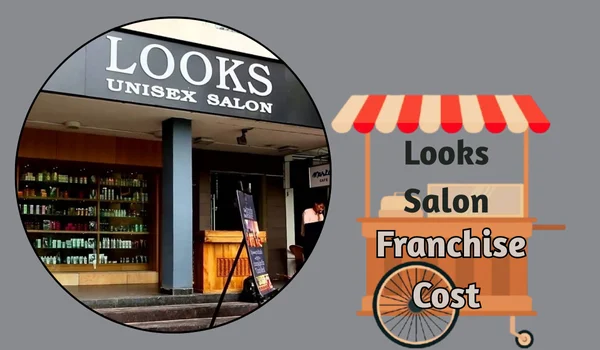If you’re eyeing the premium salon space, Looks Salon is among India’s best-known names with three decades of brand equity, a high-spend clientele, and professional training systems. Below is a practical, advisor-style guide that covers the franchise cost, business model, expected ROI, who qualifies, and the exact steps to apply—along with reality checks where third-party figures differ.
What’s the Real Franchise Cost?

Official guidance from Looks Salon’s own FAQs pegs the required investment at ₹1.0–1.5 crore (with ~₹1.25 crore described as a practical entry point). This includes the one-time franchise fee payable upfront. Treat this as the most reliable public benchmark and confirm the breakdown when you engage the brand.
Several franchise advisories also place Looks in the ₹1.2–1.5 crore band for a typical city outlet (store fit-out, equipment, branding, training and opening inventory). Your final capex depends on carpet area, city tier, mall vs. high street rents, and design spec.
Takeaway: Budget ₹1–1.5 crore all-in for a standard Looks outlet. Push higher only if you’re opting for a larger format, premium interiors, or a flagship location.
Brand Scale & Positioning
Looks Salon was founded in 1989 and has grown into a national chain. The brand’s site highlights its pan-India presence and growth ambitions; business coverage reported ~190 outlets across 51 cities in 2023, with an aggressive expansion roadmap. These signals matter because scale correlates with supply chain strength, training pipelines, and marketing recall.
Franchise Model: How the Business Works
- Format & Area: Expect ~800–1,500 sq ft for a modern, full-service premium salon (compact high-street units may be smaller; flagships can be larger). Third-party advisories commonly quote this band for Looks-style stores.
- Set-Up Scope: Interior build-out per brand handbook (zoned for hair, beauty, back-of-house), MEP, furniture, mirrors/chairs, wash units, reception/retail, signage, POS and software, and pre-opening inventory.
- Training & Ops Support: The brand typically provides SOPs, technical training, VM/grooming standards, product tie-ups, and opening guidance. (Get the latest scope in your proposal pack.)
- Revenue Mix: Core services (cut/colour/straightening, hair treatments), beauty services, bridal/makeup, plus retail of professional products to lift average bill value (ABV) and margins.
ROI: What to Expect (with a Reality Check)
Payback Window: Salon returns depend on rent discipline, chair utilization, stylist productivity, and retail mix. For a well-located premium salon with steady bookings, investors often model breakeven in ~24–36 months. Some third-party portals paint faster timelines, but the brand’s own investment guidance is a better anchor—use conservative projections and validate with existing franchisees in your city.
Key Profit Levers
- Rent-to-Sales: Aim for ≤12% in steady state. High mall rentals need strong weekend and bridal calendars to sustain.
- Chair Utilization: Track stylist hours sold vs. available; trained colourists can materially lift ABV.
- Service Mix: Chemical services (colouring/smoothing) and bridal/makeup weekends tend to drive margins.
- Retail Attach: A 10–15% retail attachment rate (pro haircare, after-care kits) meaningfully improves net.
- Talent & Training: Retaining star stylists and continuous upskilling protect ratings and repeat traffic.
Seasonality: Weddings and festivals create upswings; monsoon or exam windows may soften weekday demand. Build a two-quarter cash buffer post-launch.
Eligibility Criteria (Typical)
Looks Salon doesn’t publicly publish a rigid checklist, but patterns across premium salon franchising suggest:
- Promoter Profile: First-time entrepreneurs are welcome; prior retail/F&B/beauty experience is a plus. Hands-on ownership improves compliance and NPS.
- Capital Adequacy: Ability to fund ₹1–1.5 crore capex plus 3–6 months of working capital.
- Property: Prime frontage in an affluent catchment—malls, high streets near residential and corporate clusters. 800–1,500 sq ft is a practical planning band.
- People: Willingness to hire, train and retain a high-skill team (stylists, colourists, beauticians, manager).
- Compliance: Trade licences, GST, labour law compliances, fire safety, hygiene SOPs.
Cost Heads (Indicative Split)
While your official proposal will have a BOQ, plan broadly for:
- Franchise Fee: One-time, included within the brand’s ₹1–1.5 crore guidance.
- Interiors + MEP: Often the largest component—premium finishes, lighting, and acoustics matter for guest experience.
- Chairs/Wash Units/Backbar: Professional gear plus salon furniture.
- Tech & POS: Billing, CRM, appointments; integrate with WhatsApp/Maps for discovery and reminders.
- Pre-Opening Inventory & Training: Backbar, retail SKUs, consumables; team training and certification.
- Launch Marketing: Facade launch, local influencers, Google Maps push, bridal showcases.
Warning on outlier figures: Some third-party pages quote unusually low capex for “Looks” that are not aligned with the brand’s own FAQ. For a flagship premium experience, plan with the ₹1–1.5 crore bracket unless Looks gives you a written, format-specific exception.
Step-by-Step: How to Apply
- Submit Franchise Interest (Official): Use Looks Salon’s franchise enquiry page/contacts to register your interest. Provide your city, property size/frontage, and contact details.
- Discovery Call & Format Fit: Discuss store size, city tier, target opening, and support scope (training, launch plan, brand audits).
- Site Evaluation: Share exact address, carpet area, frontage, floor plan, power load, and rent/CAM. The brand will approve or suggest alternatives based on catchment.
- Commercials & LOI: Request a written proposal detailing capex split, franchise fee (if itemized), project timeline, training, royalty/brand charges (if any), product tie-ups, and audit cadence.
- Agreement & Fit-Out: Sign the agreement/LOI and start interiors as per brand BOQ. Begin hiring and block training slots for your team.
- Pre-Launch & Go-Live: Lock your opening inventory, run a neighbourhood teaser campaign, amplify Google Maps presence, and plan bridal/colour weekends for early traction.
- Post-Launch Operations: Track chair utilization, ABV, retail attach, ratings, and rebook %. Engage with the brand’s training calendar to keep techniques current.
Advisor Tips to Improve ROI
- Location beats low rent: Premium salons monetise through high-value services. Choose visibility and demographics over a marginal rent saving.
- Build a star team: Lead stylists and colour masters justify premium pricing and strong rebooks. Incentivise with performance pay, training, and recognition.
- Own your reviews: Guard your Google rating (4.5+ target) with SOPs for service recovery and post-visit nudges.
- Calendarise the year: Plan a cadence—bridal showcases, colour trends, member days, referral drives—to smoothen seasonality.
- Retail like a pro: Train staff in consultative retail; it raises guest outcomes and your net margins
Quick FAQs
1) How much does a Looks Salon franchise cost in India?
Plan ₹1.0–1.5 crore all-in for a standard outlet; this range includes the one-time franchise fee as per Looks’ own FAQ. Confirm the exact split for your city and format.
2) What area is required?
Advisories commonly indicate ~800–1,500 sq ft for a full-service premium salon. Your format and catchment will refine this.
3) How soon can I break even?
Use a conservative 24–36 months model; strong sites with disciplined ops can do better. Validate with current franchisees in your city and the brand’s performance benchmarks.
4) Where do I apply?
Start with Looks Salon’s franchise page and request an official proposal (capex, timelines, support, and commercials).
Bottom Line
Looks Salon is a credible, premium play for investors who can back ₹1–1.5 crore and run a people-first, service-driven business. Anchor your budgeting to the brand’s official FAQ, lock the right location, and treat training + talent retention as core investments. If you share your city, carpet area, and expected rent, I can draft a city-specific P&L with chair-wise utilization targets and a 36-month cash-flow view.

Shashi Kant is the Founder and Editor of BusinessScroller.com, a leading platform for business insights, finance trends, and industry analysis. With a passion for journalism and expertise in business reporting, he curates well-researched content on market strategies, startups, and corporate success stories. His vision is to provide valuable information that empowers entrepreneurs and professionals. Under his leadership, BusinessScroller.com has grown into a trusted source for in-depth articles, customer care guides, and financial expertise.


